Laos Travel Guide
Location and Terrain Lao P.D.R. located in the heart of the Indochina Peninsula in Southeast Asia. It lies between 14-23 degrees north latitude and 100-110 degrees east longitude. This is the only country in Southeast Asia without direct access to the sea, stretching from north to south for 1,700 kilometers. Laos covers a total of […]
Location and Terrain
Lao P.D.R. located in the heart of the Indochina Peninsula in Southeast Asia. It lies between 14-23 degrees north latitude and 100-110 degrees east longitude. This is the only country in Southeast Asia without direct access to the sea, stretching from north to south for 1,700 kilometers.
Laos covers a total of 236,800 square kilometers, while the landscape is characterized by three different regions – mountains, plateaus and plains. Mountains and plateaus make up three quarters of the total area.
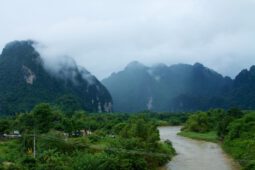
High mountains rising to an average height of 1,500 meters dominate the northern region. All three of the highest mountains in the country are located on the Phu Ane plateau in the province of Xiang Khuang. These are Fau Bia at 2820 meters, Fau Sao at 2690 meters and Fau Samsum at 2620 meters. Fu Luang (Annamite Range) extends from the southeast on the Fuang plateau to the border with Cambodia; others are the Nakai Plateau in the province of Hammuan and the Bolaven Plateau in southern Laos, which is located at an altitude of more than 1000 meters above sea level.
The lowland region consists of large and small lowland areas distributed along the Mekong River. The Vientiane Plain, the largest, is located in the lower reaches of the Nam Ngum River. The Savannakhet Plain is located in the lower reaches of the Sebangfai and Sebangieng rivers, and the Champasak Plain on the Mekong River extends to the borders of Thailand and Cambodia. Favored by rich and fertile soil, these plains represent one quarter of the total area known as the country’s granaries.
The Lao People’s Democratic Republic abounds in many rivers and streams. The largest is the Mekong River, which flows from north to south with a length of 1,898 kilometers, with the main part of the border with Thailand being 919 kilometers. It is estimated that about 60% of all water entering the Mekong River System comes from Laos. These rivers and streams provide great potential for the development of hydropower, with 51% of the energy potential in the lower Mekong basin in Laos.
Despite limited infrastructure, Laos is a wonderful country to visit. Lao are one of the most friendly and affectionate people in Southeast Asia – faithfully Buddhist and traditional in many ways. Still not used to countless visits by foreigners, helping locals and sincere welcome.
And since this landlocked nation is so sparsely populated – less than 7 million people in a territory larger than the United Kingdom – often impenetrable wooded mountains predominate in its countryside. Laos has a rich culture and history, and although in the past it has repeatedly become a battleground, today it is a peaceful and stable country.
Although Laos has opened itself up to international trade and tourism, it is still a secondary destination on most routes. Tourism professionals in Thailand and Laos are vigorously promoting a joint collaboration program, which makes it easy for Thai visitors to plan trips to Laos. Most of the Thai part of this program is based in Chiang Mai, from where Luang Prabang and Vientiane can be easily reached by air in 60-80 minutes. Most travel agents in Chiang Mai can arrange your trip to Laos for as little as $ 500 (including airfare). You can also fly to Vientiane and Luang Prabang from Bangkok or cross the Mekong via bridges to Nong Khai and Ubon Ratchathani, in the eastern part of Isan. Ferries connect Chang Kong in northern Thailand with the river port of Lao Huai Xai.
The People’s Democratic Republic of Laos is located in the center of Indochina, sharing borders with China in the north 416 kilometers, Myanmar in the north-west 236 kilometers, Thailand in the west 1835 kilometers, Cambodia in the south 492 kilometers and Vietnam in the east 1,957 kilometers.
With a total area of 236,800 square kilometers, about 70% of Laos is mountainous, reaching a maximum height of 2820 meters in Xiang Khuang province. In the landscapes of northern Laos and areas adjacent to Vietnam, in particular, rough mountains prevail.
The Mekong River is the main geographical feature in the west and, in fact, forms a natural border with Thailand in some areas. The Mekong flows through almost 1900 kilometers of Laos and forms the bulk of the lifestyle of the people of Laos. In the south, the Mekong reaches a width of 20 kilometers, creating an area with thousands of islands.
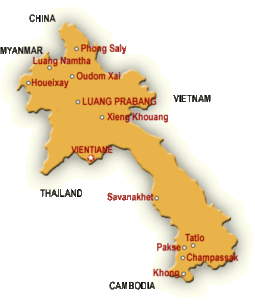
Laos has one of the most pristine ecological zones in Southeast Asia. The estimated part of the forest consists of primary forest, in particular rainforest. Unlike the vegetation that grows in the climate of Europe and the USA, the tropical rain forest consists of three plant layers. The top layer contains one trunk, a tall tree called dipterocarp. The middle canopy consists of solid wood, such as teak. Below you can find small trees, grass and sometimes bamboo.
In addition to its enchanting vegetation, Laos hosts a diverse animal kingdom. Some exotic mammals are endemic, for example, leopard cats, Javanese elk, goat antelopes, as well as rare species of gibbons and saffron mushrooms, Malayan sun bear, Asian black bear and guar. The discovery of Saola Ox, an antelope deer breed, in Vietnam several years ago caused a sensation. This extremely rare animal lives in the eastern border areas of Laos. It is believed that these remote areas probably still hide other unknown species.
In southern Laos, near Hong Island, the Irrawaddy dolphins live in the Mekong River. While many wildlife species are shy and rarely seen, viewers will usually be able to spot dolphins in spring when the water level in the Mekong is at its lowest. Laos is also rich in local and migratory birds. One of the most notable of these is the tare green peacock.
| Capital | : | Vientiane |
| Main cities | : | Luang Prabang, Champasak, Savannahet |
| Bordering Countries | : | China, Myanmar, Thailand, Cambodia, Vietnam |
| Residents | : | 5,500,000 |
| Flag | : | |
|
Languages |
: | Laos |
==============
Laos Geography
Lao People’s Democratic Republic (Lao People’s Democratic Republic) is located in the heart of the Indochina Peninsula, in Southeast Asia, at latitudes from 14 to 23 degrees north latitude and from 100 to 108 degrees east longitude.
The Lao People’s Democratic Republic shares 505 km of the border with China in the north, 435 km of the border with Cambodia in the south, 2069 km of the border with Vietnam in the east, 1835 km of the border with Thailand in the west, and 236 km of the border with Myanmar in the north-west. The length of the country from north to south is 1700 km, and the width from east to west exceeds 500 km, and in the narrowest – only 140 km.
The Lao People’s Democratic Republic covers a total of 236,800 square kilometers, three quarters of which are mountains and plateaus. There are three separate regions in the country.
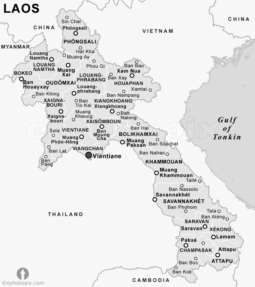
In the north, mountains prevail, an average of 1,500 meters above sea level. The highest peak is 2800 meter high Phu Bia in Xiang Khuang province. Fu Luang (the Annamite chain) extends from the southeast of the Fuang Plateau to the border with Cambodia. It has three large plateaus: the Fuane plateau in the province of Xiang Khuang, the Nakai plateau in the province of Hammuan and the Boven plateau in southern Laos, 1000 m above sea level.
The plains area includes large and small plains along the Mekong River. The largest of them is the Vientiane plain, in the lower reaches of the Nam Ngum River. Also important are the Savannakhet Plain in the lower reaches of the Se Bang Fai and Se Bang Hieng rivers and the Champassak Plain, located on the Mekong River, stretching between the borders of Thailand and Cambodia. Fertile in fertile soil, these plains represent a quarter of the total area and are the “granaries” of the country.
The Lao People’s Democratic Republic crosses many rivers and streams. The Mekong River flows through 1835 km of the country from north to south. Rivers and streams provide great potential for hydropower development. More than half of the energy potential in the lower Mekong Basin is in Laos.
The Nam Ou River flows from Phonsaly to Luang Prabang at 448 km; Nam Ngum runs 354 km from Siang Khuang to the province of Vientiane; the length of Xie Bang Hieng of the province of Savannakhet is 338 km; Nam Ta runs 325 km from Luang Namta to Bokeo; Nam Sekong runs 320 km from Saravane and Secong to the province of Atopeu; Xie Bang Fai is located between Hammuan and Savannakhet at 239 km; Nam Beng of Udomsai Province extends for 215 km; Nam Sedong flows over 192 km between Saravane and Champasak; Nam Selanong in Savannakhet extends for 115 km; the length of Nam Kading, Borikhamsai region – 103 km; Nam Khan runs 90 km between Huaphan and Luang Prabang.
Being a tropical country, the weather in Laos is influenced by monsoons. The weather in the mountains in the north and in the high range of the Annamite Chain bordering Vietnam in the east is semi-tropical. The difference in day and night temperatures is about 10 deg C.
Laos has about 2,300 to 2,400 hours of sunshine per year. Atmospheric humidity is usually 70-80%, and 75-90% of precipitation is recorded in the rainy season, from May to October. The rainfall in the dry season, from November to April, is only 10-25%. There is a sharp difference in rainfall between regions. For example, in Fu Luang (annamite chain), the average annual rainfall is about 300 millimeters. In the provinces of Xianhuang, Luang Prabang and Sayaburi, the annual rainfall is 100-150 mm; in Vientiane and Savannahet, 150-200 millimeters of precipitation per year.
Laos has an abundance of natural resources. Under the earth’s surface, mineral deposits include tin, iron, coal, zinc, copper, gold, silver, sulfur, and sapphires. Although mining is still in its infancy, studies show that the quantity and density of mineral deposits are quite high. On the surface, the country has a wealth of forests covering 47% of the surface. They include a variety of species, many of which are of high economic value, such as Hagnung, Khamphi, Dow, Eaglewood and Longleng ..
Forest areas are also rich in non-wood products such as shellac, benzoin, cardamom, pine resin, rattan and medicinal plants, and there is a wide range of fauna, including elephants, tigers, bears, deer and recently discovered deer species named Saola.
Such wealth represents a huge potential for the development of the country, ensuring a brighter future and improving the living standards of its people.
==============================
People and Population
– Population: 6.5 million people.
– Density: 23 people / sq.
– The population consists of 49 ethnic groups, in 4 main language groups.
- The Lao Thai family includes 08 ethnic groups: Lao, Phutai, Thai, Liu, Gunan, Young, Saek, and Thai Nope.
- The Mon Khmer family includes 32 ethnic groups: Khmu, Pray, Singmu, Khom, Tine, Idu, Bid, Lamed, Samtao, Katang, Makong, Tri, Trieng, Tao, Ye, Brao, Harak, Katu, Oh. , Krieng, Yrou, Souai, Gnaheune, Lavy, Kabkae, Khmer, Toum, Ngouane, Meuang and Kri.
- The Tibeto-Burmese family includes 07 ethnic groups: Akha, Singsali, Lahu, Strength, Haya, Lolo and Choir.
- The Hmong Lumien category includes 02 main tribes: Hmong and Lumien (Yao). These multi-ethnic peoples are scattered throughout the country, each with their own unique traditions, culture and language.
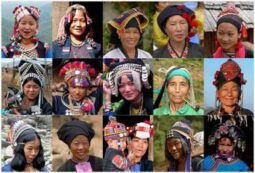
It is believed that Laos has somewhere from 70 to more than 100 ethnic groups (no one can be sure!), And they are divided into four main cultural and linguistic collections. Hill tribes make up a large part of the population, although it is unclear how many ethnic groups actually exist in Laos; The numbers range from government list 68 to ratings of independent ethnographers 120 or more. The rich and complex language mix of Laos is such that in extreme cases, some minorities consist of only a few hundred people and occupy only a certain peak or valley!
Lao, or Lao lowlands, speak Lao Thai and live in lowlands and cities and along the Mekong River. Lao make up about two-thirds of the country’s total population.
Lao Thai, or tribal Thai, include black Thai and red Thai (the so-called depending on the color of the clothes of their women), who live throughout the country, especially at high altitudes.
Lao Thun speaks Mon-Khmer languages and is often called the Austro-Asian peoples (the largest group is kammu). It is believed that these peoples are descendants of the earliest peoples of the region; they live all over Laos and in neighboring countries, and their settlements are usually located on slopes at moderate heights, and this pattern could have been caused by immigration pressure from the early Lao, who eventually captured the valleys.
The Laosong group, which includes the Hmong (Meo or Miao) and the man (Yao), probably migrated from southern China to Laos at the end of the 18th century and live in the mountains at the highest elevations, since most other land territories were already occupied in time of their arrival.
Each of these groups and their units have their own culture, but this website focuses on the Lao lowland culture.
In the Jars Plains area, the most numerous peoples are the plains of Lao, Hmong, Black Tai and Kammu. The Poins, the Lao plain of the flasks, are a group of low-lying Lao, whose language and customs are slightly different from Lao looms in other regions. Nevertheless, in our time, after frequent population movements to and from the region, they were assimilated into the main Lao group, and their language, for all practical purposes, approaches the common Lao language, with the exception of some vocabulary and tonal differences.
Lao lowland has much in common with the Thai people. Having a common origin, the language and customs are basically the same, while most of the differences between them are largely the result of the last 500 years of history, when their fates went their separate ways.
However, one noticeable difference is the food. Laotians have a tradition of eating raw foods, including wild meat, buffalo and fish, as well as raw vegetables, many of which are wild herbs, herbs, leaves, and roots.
This may be due to the forested mountainous nature of their environment. The type of rice that Laotians eat is also different – glutinous or glutinous rice, which is eaten by kneading a small handful in a ball and lowering it into a seasoning dish. Sticky rice is served in reed baskets with a tight-fitting lid that is worn and removed. When Laotians go to work in a field or another place, you often see a small version of these round wicker baskets with sticky rice hanging on their side and, possibly, a small amount of fish or meat that will serve during the day. food. The most common dish eaten with glutinous rice is pa dec, a very spicy fermented fish sauce. On the back porch of a Lao peasant’s house, you can see a clay jar with a fermented pase deck.
The second distinctive dish of Lao is som (mahong there), which is a salad of strips of unripe papaya, chili, pieces of crab, small eggplant and pall, another form of fermented fish. And then there is Laap. This is done with fish, chicken, duck, pork, beef, buffalo or game. The meat and entrails, often raw, are finely chopped and seasoned with onions, chili. and other herbs such as mint and lemon grass.
===============================
Laos Climate
Most of the year is hot and humid. Laos enjoys a tropical climate with two distinct seasons. The rainy season is from the beginning of May to the end of September, and the dry season is from October through April. The yearly average temperature is about 28 degrees Celsius, rising to a maximum of 38 degrees Celsius during April and May.
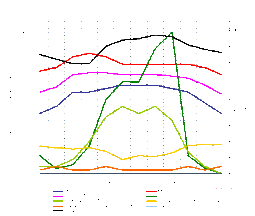
In Vientiane a minimum temperature of 19 degrees Celsius is to be expected during January. In mountainous areas, however, temperature drops to as low as 14-15 degrees Celsius during the winter months, and during cold nights, can easily reach the freezing point. The average precipitation is highest in Southern Laos, where the Annamite Mountains receive over 3,000 mm. annually. In Vientiane rainfall is about 1,500-2,000 mm., and in the Northern provinces only 1,000-1,500 mm.
When to go
The best time for visiting most of Laos is between November and February, when it rains the least and is not too hot. It’s also Laos’s main season for both national and regional bun (festivals).
If you plan to focus on the mountainous northern provinces, the hot season (from March to May) and early rainy season (around June) is not bad either, as temperatures are moderate at higher elevations. Southern Laos, on the other hand, is best avoided from March to May, when day-time temperatures break into the 40s and nights aren’t much cooler.
The rainy season is not as bad as you might think. While it will rain – very heavily – the downpours are often fairly brief and can be bracketed by long periods of sunshine. The rains also clear dust from the skies and land, making everything clearer and brighter. Of course, there are downsides; unsealed roads can become quagmires and extensive travel in remote areas like Salavan, Phongsali and Sainyabuli might be impossible. River travel can be a good alternative during these months. If you intend to travel extensively by river, November is the best; flooding has usually subsided yet river levels are still high enough for maximum navigability. Between January and June, low water can make navigating some rivers difficult.
December to February and August are the peak tourist times. January, in particular, is very busy and booking ahead is advisable.
=========================
Lao visa policy
With the launch of e-Visa scheme in July 2019, now the citizens of all nations can easily apply for Visa to Laos. We recommend you apply for this online visa as it helps avoid the tired long queue at the airport.
For the one forgetting to apply for e-Visa, you can easily apply for Visa on arrival, but it is only eligible for a list of selected countries.
Others, you can apply for Visa at Lao embassy before boarding the flight to Laos.
In general, Laos visa policy is quite easy and straight forward, that can be divided into 4 main categories: e-Visa, Visa Free or Visa Exemption (14-15-30 days), Visa on Arrival (30 days), and Visa or official approval required in advance for 32 blacklisted countries.
Let’s check the map below for the general idea.
Visa Online (Electronic Visa or e-Visa)
Laos government launched the online Visa (e-Visa) scheme on July 9th, 2019 for the citizens of all nations.
It is now the most convenient way to apply for tourist visa. Let’s check out below.
What is Laos e-Visa
The E-Visa Laos is an electronic travel authorization which the Laos government has launched officially in July 2019. Citizens from eligible countries can apply online for their e Visa Laos.
As soon as the e visa to Laos is approved, the travelers will be able to stay in Laos for tourism purposes for a maximum period of 30 days for a single entry.
To be able to benefit from this easy and rapid way of obtaining an eVisa, applicants must provide the correct information concerning their passport.
When arriving in Laos, travelers must show their approved Tourist E visa Laos to the border authorities to enter the country.The Laos E visa application is aimed to make more fluid the immigration process and to amplify the border security checks.Applicants must answer some questions and give details such as their full name, address, date of birth, passport details, and travel plans, when doing their application online.
Tourist Visa on Arrival
The Lao government issues 30-day tourist visa on arrival at all international airports and most international border crossings.The whole process is very straightforward. You need between US$30 and US$42 in cash, one passport-sized photo and the name of a hotel or guesthouse.Those without a photo, or who are arriving on a weekend, holiday or after office hours, will have to pay an additional one or two dollars.The visa fee varies depending on the passport of origin, with Canadians having to fork out the most (US$42) and most other nationalities paying between US$30 and US$35.It’s cheaper to pay in US dollars as a flat rate of 1500B (around US$45) is applicable in Thai baht. No other foreign currencies are accepted.
Where to Get Laos Tourist Visa on Arrival
At the moment, you can apply Laos Visa on arrival at 4 International Airports, 16 Border checkpoints, and 1 Train Station.
3 International airports
- Wattay International Airport in Vientiane Capital;
- Luang Prabang International Airport in Luang Prabang Province;
- Pakse Internatioanl Airport in Champasack Province;
9 International Border checkpoints
Laos – Vietnam: 1 International borders
- Dansavan – Lao Bao (Savannakhet – Quang Tri)
Laos – Cambodia: 1 International border
- Dong Kralor – Stung Treng (Champasak – Stung Treng)
Laos – Thailand: 6 International borders & 1 Train station
- Huayxay – Chiang Khong (Bokeo – Chiang Rai)
- Lao-Thai Friendship Bridge I (Vientiane – Nong Khai-Udon Thani)
- Tha Laneng Train Station (Vientiane – Nong Khai-Udon Thani)
- Lao-Thai Friendship Bridge III (Thakhek – Nakhon Phanom)
- Lao-Thai Friendship Bridge II (Savannakhet – Mukdahan)
- Vangtao – Chongmek (Champasak – Ubon Ratchathani)
Laos – China: 1 International border
- Boten – Bohan (Luang Namtha – Yunnan)
We have marked all the Laos Visa on arrival entry points in the Google Maps, please check below for your reference
Visa at the Embassy (Mostly for Blacklisted Countries)
In most of the case, Visa on arrival is the most convenient and recommended method to apply Visa to Laos.The visa issued at the embassy is generally for the tourists from Blacklisted countries only (33 countries listed above).However, in case you want to have visa ready before boarding the flight to Laos, you can also have it at one of the Laos Embassy or Laos Consulate.
General Requirement (maybe varied depending on the embassy that you visit)
- Valid passport with remaining validity of at least 6 months from the date of your entry;
- Two blank pages on your passport (Lao visa stamp takes up a whole page, plus there has to be space for immigration stamps too);
- Two recent photographs (3cmx4cm), in color, front view and with a plain/light background;
- Duly filled Visa Application Form with one photograph attached;
- Visa fee (amount depends on your nationality and where you apply);
- A copy of your itinerary.
Laos Religion
Buddhism first appeared in Laos during the eighth century A.D., as shown by both the Buddha image and the stone inscription found at Ban Talat near Vientiane, now exhibited at Hor Pra keo Museum. After the foundation of the unified Kingdom of Lane Xang, King Fa Ngum (14th Century) declared Buddhism as the state religion and urged the people to abandon Animism or other beliefs such as the Cult of Spirits. His policy meant to develop the Lao culture based on a common faith: Theravada Buddhism.
Today, Theravada Buddhism is the professed religion of about 90% of Lao people. Buddhism is an inherent feature of daily life and casts a strong influence on Lao society. Lao woman can be seen each morning giving alms to monks, earning merit to lessen the number of their rebirths. It is expected that every Lao man will become a monk for at least a short time in his life.
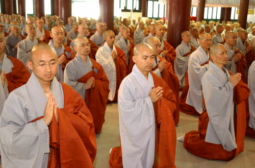
Traditionally, men spent three months during the rainy season in a Wat (Buddhist temple). Today, however; most men curtail their stay to one or two weeks.
Lao religious images and art is also distinctive and sets Laos apart from its neighbors. The “Calling for Rain” posture of Buddha images in Laos, for example, which depicts the Buddha standing with his hands held rigidly at his side, fingers pointing to the ground, can not be found in other Southeast Asian Buddhist art traditions. Religious influences are also pervasive in classical Lao literature, especially in the Pha Lak, Pha Lam, the Lao version of India’s epic Ramayana.
Projects are underway to preserve classic Lao religious scripts, which were transcribed onto palm leaf manuscripts hundreds of years ago and stored in Wats.
=========================
Laos culture
Lao people are frank, open and friendly, and they possess a strongly developed sense of courtesy and respect. Everyone who adheres to the latter will receive a warm welcome.
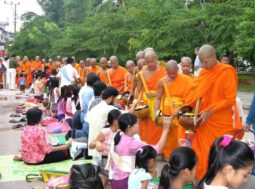
The generally accepted form of greeting among Lao people is the Nop. It is performed by placing one’s palms together in a position of praying at chest level, but not touching the body. The higher the hands, the greater the sign of respect. Nonetheless, the hands should not be held above the level of the nose. The nop is accompanied by a slight bow to show respect to persons of higher status and age. It is also used as an expression of thanks, regret or saying good-bye. But with western people it is acceptable to shake hands.

The feet form the inferior part of the body (as much spiritually as physically). You must never indicate or touch another person or object with your foot.
Daily life and social customs
Most families in Laos are involved in farming. Members of households work the land together, with a division of labour by gender. In wet rice cultivation, men plow and prepare the seedbed, control water flow to the fields, and thresh the crop. Women transplant the seedlings, weed the fields, and carry the sheaves of rice to the threshing place. In upland rice cultivation, men cut and clear the swiddens, while women do the sowing and weeding. Wet rice cultivation begins with the onset of the rains in April or May and ends with the harvest in October and November. In upland areas, fields are burned and cleared at the end of the dry season in February and March, and harvesting takes place in November. Cultivation of secondary crops is interspersed with rice cultivation; gardening on river banks, for example, follows the drop in water level at the end of the dry season.
In addition to strictly agricultural activities, the daily lives of rural people involve a number of other tasks, such as fetching water from wells, hunting for game, and gathering various forest products. Common forest products include small game, birds and … (200 of 10,312 words)
Laos Social Rules
The Lao people greet each other with a prayer-like gesture called a nop. A younger person or a person of lower status will nop their elder or social superior. The western custom of shaking hands has become more common in recent years – though a smile and a slight bow of the head is still considered polite. Backslapping, public displays of affection, shouting, and wild gesticulation are all considered impolite.
The head is considered the highest part of the body, while the feet are considered the lowest, both literally and figuratively. Touching someone’s head or pointing at people or things with the feet are, therefore, considered extremely rude. As with entering temples, shoes are removed before entering somebody’s home.
Greetings
For Men greeting Men – The standard Lao greeting is, “Sabaideebor” which means”how are you?” or “are you well?” This is usually done with both hands pressed together in a prayer in front of your body and accompanied with a slight bow or nod. The response for “sabaideebor” is usually “sabaidee”. Some men will also use a standard handshake. These tend to be on light side. Always smile during greetings.For Women greeting Women – The standard Lao greeting is, “Sabaideebor” which means “how are you?” or “are you well?” This is usually done with both hands pressed together in a prayer position just below the chin and accompanied with a slight bow. The response for “sabaideebor” is usually “sabaidee”. Always smile during greetings.Greetings between Men and Women – The standard Lao greeting is, “Sabaideebor”which means “how are you?” or “are you well?” This is usually done with both hands pressed together in a prayer position just below the chin and accompanied with a slightbow. The response for “sabaideebor” is usually “sabaidee”. Always smile during greetings.
Notes: The person who is socially inferior or younger should be the first to bow, but it is considered polite for the older/socially superior person to respond quickly. The higher the hands are held and the lower the bow, the greater the degree of respect. When addressing a social equal, the hands are usually held at the level of the mouth; when addressing a person of higher social standing (this includes monks, regardless of age), the hands are usually held in front of the nose; and when addressing a younger/socially inferior person, they are usually held at the chin.
Wedding and Marriage
In Laos culture, before a Lao wedding takes place, (after the proposal) a traditional procession call Sou Khor is arranged (an envoy of the boy sent to the girl to ask if her parents will allow the marriage). If her parents agree to let their daughter to marry the boy, a Kha Dong (bride-price) is negotiated as well as who pays for what at the wedding. This is usually the groom, but today often both parties share the expenses. The Sou Khor session takes place several days or even months before the wedding.
Once married, the couple lives with the parents of the bride until after the marriage of the next daughter (if any) or in some cases they move out earlier but the earliest is seven days after their wedding.
When the couple has children, the stay-at-home parents or grandparents usually help raise their grandchildren before they reach school age. Grown-up children usually also live in until they get married and sometimes even until after they have their own children so that the grandparents can help raise them or sometimes until they save enough money to build their own house. However, one of the children (usually the youngest daughter in big families) lives with the parents, inherits the main house, and takes the responsibility of taking care of aging parents. The moved-out children support their parents by sending money back if they live far away, otherwise they come to visit and eat together as a family very often.
In Laos there is no social security or other welfare, such as homes for the elderly provided by the government. However, as our family bonds are strong and everyone in the family helps everyone out it is an important part of our culture to take care of our aging parents and grandparents. This might change in the future because the Lao simple life is slowly being replaced by modern lifestyles and the extended families are gradually being replaced by nuclear ones as people have fewer children these days.
Laotian Literature
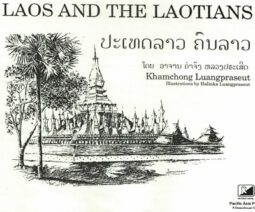
Unfortunately very little is known concerning the history of Lao’s literature because early society was generally decentralized and isolated, and the quality of parchment did not lend itself to preservation, which in turn led to the written word becoming illegible in a relatively short time. The political insatability, especially in areas such as Sieng Khuoang (the Plain of Jars) was as well a barrier to a more enduring literary heritage.
Laotian language was created in the fourteenth century and is read from left to right. The Laotian language contains fifteen vowels and thirty constants. The first record of Laos’s traditional literature is from the 15th and 16th century and it differs prominently from western literature because Laos does not write fiction literature. Of all the literature that has been written ninety percent has a Buddhist religious theme, or else historical as traditional literature was not meant for entertainment, but rather, as an education or a teaching tool. Popular literature, in contrast, is maintained by an oral tradition of folk tales.
Spirit Gates
Many hill tribe villages have spirit gates on the paths above and below each village, to protect the residents and deter evil spirits. Some of these may have male and female wooden figures alongside. These gates act as a kind of barrier to the spirits outside the village and provide a way of purifying villagers returning from the forests. In most cases, they are never taken down, but they are rebuilt every year with a ceremony dedicated to the spirits. Usually, only men are involved in this activity. The top of the gates may be adorned with figurines, effigies, animal parts, or carvings depicting weapons such as an AK-47.
The Akha in the Golden Triangle region are the peoples most often associated with spirit gates, however most tribes that live in forested mountains in Asia construct them, including the Hmong. For some hill tribes, if a visitor enters a village through a gate, it is obligatory to enter at least one house.
The Spirit Gate is used to separate the human world from the spirit world, Everything beyond the village gate is considered as part of the domain of the spirits. If one were to venture forth into the forest, they would be at the mercy of the spirits, which may follow that person back to the village to bring sickness or some other misfortune. Upon returning to the village, that person is expected to pass through the village gate in order to exclude any malicious spirits.
Occasionally, there would be a rash of sickness running through the village, and this would be interpteted to mean that the spirits are running havoc on the community, which requires an offering to be made to appease them.
Communication Style
– Verbal communication tends to be non-confrontational and indirect.
– Many Laotians will offer you the response they assume you want to hear, regardless of their feelings or plans. Be prepared to receive seemingly contradictory information from different sources, and try to stay calm in these situations.
– Showing frustration with people in public does not usually win you any points. It may be more helpful to ask various simple yes/no questions of different people in order to put together a picture of the situation than to ask complicated how/why questions that may make someone uncomfortable.
– When there is a conflict, it is often resolved through an intermediary. Don’t expect to discuss the issue directly with the person who has taken offense. Once the problem has been resolved, the two parties can meet congenially without addressing the conflict.
– “Yes” does not always mean “yes” and “no” may be substituted for “maybe”, “possibly” or even “yes”. It’s best to pay attention to non-verbal cues such as facial expressions and body language.
– Laotians tend to have various types of smiles. Some indicate pleasure while others embarrassment or even anger.
Etiquette and Behavior
Laotians are generally gentle and polite, and visitors should take their lead from them—avoiding any public display of anger or impolite behavior. Even showing affection in public is frowned-on.
Laotians traditionally greet others by pressing their palms together in a sort of prayer gesture known as a nop; it is also acceptable for men to shake hands. If you attempt a nop, remember that it’s basically reserved for social greetings; don’t greet a hotel or restaurant employee this way. The general greeting is sabai di (“good health”), invariably said with a smile.
Avoid touching or embracing a Laotian, and keep in mind that the head has spiritual significance; even patting a child affectionately on the head could be misinterpreted. Feet are considered “unclean,” so when you sit, make sure your feet are not pointing directly at anyone, and never use your foot to point in any situation. Shoes must be removed before you enter a temple or private home, as well as some restaurants and offices.
Shorts and sleeveless tops should not be worn in temple compounds. When visiting a temple, be careful not to touch anything of spiritual significance, such as altars, Buddha images, or spirit houses. Ask permission from anyone before taking a photograph of him or her.
==========================
National flower – Dok Champa
National flower – Dok Champa: You might know the Dok Champa by its other name, the frangipani. This evocative tropical flower, with its sweet romantic fragrance, is seen everywhere from north to south in Laos, most especially decorating the vats and monasteries. You might even receive a string of these white-and-yellow flowers around your neck as a welcoming gesture, or see a bunch of them used to decorate a ceremony, But everywhere the meaning of Dok Champa for Laotians is the same : Joy in life and sincerity.
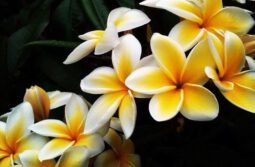
========================
Laos language
The Lao language resembles Thai, with familiar tones and sounds found in each. While some vocabulary words might cross over, the two tongues — spoken and written — are quite distinct. However, many Lao understand Thai (learned from school texts and TV), so if you’ve picked up some words and phrases in Thailand, they’ll still be useful here; people will understand and correct you with the appropriate Lao phrase.
Thankfully, many people in Vientiane and Luang Prabang speak English, and older citizens will usually be able to speak French. Russian is not uncommon, and Chinese is growing in accord with the rising Chinese population (mostly in the north).
Like Thai, Lao has no officially recognized method of Roman alphabet transliteration. As a result, even town and street names have copious spelling irregularities, so for the vocabulary below, only phonetic pronunciations are listed. Most Lao will understand you, even without proper tones, and will appreciate your efforts to speak their language.
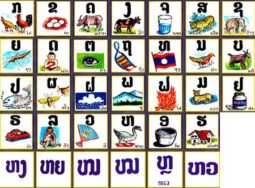
=========================
Laos Food And Cuisine
Due to its affection for fresh vegetables and herbs, which appear in almost every Lao meal. Both meat and fish are usually grilled or steamed and as a result, the flavours are fresh and the dishes are low in fat.
Lao cuisine has many regional variations, due in part to the fresh foods local to each region. You can either enjoy and authentic Lao meal (khao niew or sticky rice is a staple) in many of the restaurants or spend a morning to cook delicious Lao dishes for your lunch.
Lao food is traditionally eaten with sticky rice using fingers. In the countryside, people all eat as family style, sitting on the floor, sharing a few dishes. Lao traditional food is dry, spicy and very delicious based on fish, buffalo meat, pork, poultry and especially herbs. It is always being freshly prepared and not being preserved. Other than sticky rice, which can be eaten either sweet or sour, or fermented and is eaten with fingers, Laotian food is very rich in vegetables and is often browned in coconut oil.
Laap
Laap is a traditional Lao food is made from chopped meat, chicken or duck is a favorite. The finely chopped meat spices and broth is mixed with uncooked rice grains that have been dry fried and crushed. Laap is eaten with a plate of raw vegetables and sticky rice.
Tam Mak houng
Tam Mak houng or Papaya salad is a type of salad made from sliced raw papaya, garlic, chile, peanuts, sugar, fermented fish sauce and lime juice.
Padeck
Padeck is the distinctive and unique Lao traditional food. It’s a mixture of fish and salt that is marinated and preserved in a jar for minimum of a year up to 3 years.
===========================
Laos Transportation
Transportation would not be a problem during your Laos tours. Laos possesses a number of modern transportation systems, including several highways and a number of airports. Yet the Rail transport does not play a significant part in Laos’s transport sector.
Getting to Laos
By Flight
There are a few airlines that handle international flights in Laos. In Vientiane and Luang Prabang they are Lao Airlines, Thai Airways and Vietnam Airlines while the Bangkok Airways only serves in Vientiane. The third international airport launched in Paske, offering flights to and from Siem Reap (Cambodia) and Ho Chi Minh City (Vietnam) by Lao Airlines. Therefore, with direct flights, it’s easy for visitors to take short travel to neighboring countries by air.
By Train
There is an overnight sleeping train which departs from Thailand at 8pm every night and arrivals at the frontier of Laos the next morning. Visa on arrival is available. It’s cheap to afford, but not many people opt to take due to the rare known location of the station and the poor service on train.
Getting around Laos
By Flight
Major tourist cities are well connected by moderate-priced flights. The Lao Airlines is the only carrier that serves domestic flights and offers routes like Vientiane – Luang Prabang, Vientiane – Pakse, and Vientiane – Savannkhet. The trip is shorter than you can imagine. In high seasons the ticket is hard to book so please contact us to make your booking at an early stage.
By Boat
River is a shortcut for those who have put up with the horrible road condition of Laos. The main Mekong route linking Houayxai to Luang Prabang is the tour we can do on this itinerary.
By Taxi
It charges with meters and certainly not a good option for sightseeing. Indochina Odyssey Tours offers air-conditioned, insured, clean vans for your convenience. With our private van and tour guide service, you can stop off at any spots that you want to take a photo of and suffer from no pressure of staying too long at certain attraction sites.
By Highway
Just as mentioned at the beginning of the article, highways of Laos have been improved a lot in recent years. Transportation choices including bus and truck are becoming popular with travelers. The capital Vientiane is connected by asphalt road with other cities like Luang Prabang, Vang Vieng and Savannakhet. Be mindful that traveling by highway takes up to more than 10 hours than by plane.
By Motorbikes or Tuk Tuk
Motorbikes are for the adventurous ones in Vientiane. It’s suggested put on a helmet and bring with your motorcycle license since police are zero tolerant about those who without one. Tuk tuk is a common mean of transportation in Laos. Passengers are expected to pay for each destination with negotiable price before the ride.
==========================
Laos Travel Tips
1.Telephone & Mobile Phone
You can make international calls at Laos Telecom offices in most provincial capitals or post offices. Calls to most countries usually cost between 0.75USD and 1.80USD per minutes. Still, cyber cafes are a cheaper way to go. If you want to use your mobile phone in Laos, the simplest and cheapest way is to buy a prepaid phone card from most mini-marts or phone shops for around US$10. The major phone providers are Tango and Laotel. Or check if your phone company has international roaming coverage in Laos.
- Internet
You will find plenty of internet cafes in larger towns and cities, and in many guesthouse and hotels as well. Wi-fi is available in some upscale hotel.
- Voltage
The usual voltage is 220V. Power supplies can be erratic, so be prepared to be flexible. Plugs with two round pins are more popular than the three-pin. If you have any devices needing a special outlet, please bring its adapter kit. The best investment is the universal AC adapter, which will enable you to plug it in anywhere.
- Money
The official national currency in Laos is the Lao kip (LAK). Kip notes come in denominations of 500, 1000, 2000, 5000, 10, 000, 20, 000 and the recently printed 50, 000 kip. Three currencies are used in Laos: Lao kips, US dollars, and Thai baht, the latter two are readily acceptable in large cities and towns at most business.
– Please note that only new crisp notes are accepted in Laos. US$100 notes receiving a better exchange rate; US$ notes of the series number before 1996 as well as US$100 notes with the series number CB, dirty and/or damaged notes, or notes with any writing on it are not accepted in Laos. Please bring some small changes with you for your convenience.
- Credit card
A growing number of hotels, upmarket restaurants, and gift shops in Vientiane and Luang Prabang accept Visa and Master Card, and to a much lesser extent Amex and JCB. Outside of these three towns, credit cards are virtually useless and kip is more preferred. Major banks in Laos like Banque pour le Commerce Extérieur du Lao (BCEL) has branches in Vientiane, Luang Prabang, Vang Vieng; Savannakhet and Pakse offer cash advances/withdrawals on Visa credit/debit cards at a 3% transaction fee, other banks may have slightly different charges. Advances/withdrawals can be made in Lao kip only when it’s not possible to withdraw US dollars or Thai baht.
- ATMs
Travelers may get cheered to know that ATMs have made a tentative landing in Laos. But before you get overexcited, the ATMs are only available in Vientiane, Vang Vieng and there is a maximum of 700,000 kips (about US$70) a time, with each withdrawal incurring a US$2 fee from BCEL. Taking your plastic into the bank itself might be cheaper If you have to pay relatively high charges to your home bank on each overseas withdrawal. Please note that ATMs dispense cash in Lao kip to Visa and Master Card accounts only.
- Travelers Cheques
Travelers Cheques can be cashed at most banks in Laos, but normally only in exchange for kip. Cheques in US dollars are the most readily acceptable, and in fact outside Vientiane the only cheques accepted. Very few merchants accept traveler’s cheques.
- Clothing & Shoes
In Laos, remember to take off shoes before entering private houses and religious sites. No sleeveless top and short pants are allowed in religious sites. Men should wear tops and women should avoid skimpy tops and tight shorts. In addition, you will gain more respect if you are well turned out and modest in your dress. Check out the Laos weather to prepare fitting clothes.
- Drinking Water & Food
Drink only purified bottled water. Many hotels provide complimentary bottled water in rooms, and if not, it is very convenient to buy in a local store; only eat well-done meat and fish. Vegetables should be cooked and fruit peeled.
- Immigration
Receipt of purchase and an export permit voucher for locally bought goods such as gems and jewelry may be required upon departure.
- Time
Laos is 7 hours ahead Greenwich time.
- Photos
Generally, the Lao do not have any objections against being photographed. However, being politely to obtain his/her approval. It is not a problem anymore to bring along video cameras. Many pagodas charge a minimal fee for cameras; video cameras might be a little expensive. Some museums restrict photography. Read the rules at the tourist attractions before you get in.
- Tipping
While tipping has now become an accepted practice in Asian countries, it should always be considered a gesture of appreciation for good service and not an obligation. It is an incentive to guides to maintain a high-level service, helpfulness, and friendliness and we strongly insist to allow our clients a choice in this matter. Therefore our tour price doesn’t include a fixed amount to cover all potential gratuities.
If you would like to know the proper amount for tipping, the following standard is for your reference:
1) If you are traveling in a small group between 2 and 5 members, We suggest approximately US $10 to US $15 /per guest per day as tips for tour guide and driver and about US $3 to US$ 2 for hotel bellboys as a gratitude for their service.
2) If you are coming in a group like 6 to 9 members, We suggest US $8 to US $10 /per guest per day as tips for the guide and driver and about US $2 to US $3 for hotel bellboys as a gratitude for their service.
3) If you are traveling in a group with more than 10 people, We suggest US $5 to US $7 /per guest per day as tips for the tour guide and driver and about US $3 to US $5 for hotel bellboys as a gratitude for their service. Above is for your reference only, again tipping is a personal matter, and you can always adjust the amount based on your satisfaction with the service you get from your tour guides, drivers, bellboys and so on.
- Suggested Things to Bring
– Sun hat, sunglasses, sun lotion;
– Prescription medicines, antibiotic cream for minor cuts and scratches;
– Insect repellent; toothbrush, toothpaste or other toiletries;
– Umbrella, a small flashlight, sandals, international adaptor;
– Extra passport photos;
– Decaffeinated coffee (if you require).
- Monks & Nuns
Respect: please show respect in certain manners to the monks and nuns; argument and criticism on their religions are taken insulting. Please ask for permits before photo shooting. Moreover, women are not allowed to touch monks, also women should put the object within the monk’s reach while passing stuff.
- Emergency Numbers
Police: 119
Ambulance: 195
==========================================
LAOS THINGS TO SEE
VIENTIANE CAPITAL
Location: Central Laos
Distance: 0 km from Vientiane Capital
Population : 768,743
Total Area: 3,920 square kilometers
Administration Division: The Capital is divided into 09 Districts namely Chanthabouly, Sikhottabong, Xaysettha, Sisattanak, Naxaithong, Xaythany, Hadxaifong, Sangthong & Pak Ngum
GENERAL INFORMATION ABOUT VIENTIANE CAPITAL
Vientiane, also spelled Viangchan, largest city and capital of Laos, situated on a plain just northeast of the Mekong River. The city’s central river port location in a country relying heavily on its rivers for transportation and its surrounding hinterland of intensive rice cultivation have made Vientiane the major economic centre of Laos. The city has a tropical monsoon climate, every month having an average daytime temperature above 80 °F (27 °C) and more than 80 percent of Vientiane’s annual precipitation on the average falling in the five months May–September.
The town was founded during the late 13th century, and in the mid-16th century the capital of the Lao kingdom (a state known as Lan Xang) was moved to Vientiane from its previous traditional location at Luang Prabang (now Louangphrabang). In 1778 Vientiane came under Siamese control; in 1828 it was sacked and destroyed when the subject Laotian king revolted against Siamese hegemony. From 1899 to 1953, with the exception of the Japanese occupation (1945), Vientiane was in succession the seat of the French governor and the French administrative capital.
Vientiane still has some of its older wooden structures, despite its government offices, foreign embassies, and schools. Its modern industries include brewing, lumber processing, and the manufacture of brick, tile, textiles, cigarettes, matches, detergents, plastic bags, rubber sandals, and iron and steel. The Lao farmers of the surrounding area tend rice, corn (maize), and livestock in some of the best alluvial lowlands of Laos. Before 1975 the city was the principal stock shipping and slaughtering centre of the country. Since the shift in the country’s import trade from Vietnam to Thailand, Vientiane has replaced Pakxé to the southeast as Laos’s principal port of entry.
RESTAURANTS & CAFES
Most of the restaurants, cafes are in the main “downtown” area and getting around is easy on foot, by bicycle or by tuk tuk. There are several mini markets selling western food and other necessities.There is a big variety of cuisine, from the local street food to good quality Lao and international restaurants including European, Indian, Japanese and vegetarian eating places.
PLACES TO VISIT IN VIENTIANE CAPITAL
There are many temples in the town itself, so it is easy to stroll around and visit most of them, but remember the dress rules – women should wear modest clothes (covered arms and at least knee-length shorts and skirt, and men in T-shirts and shorts at a minimum) and shoes should be removed before entering a temple. Once a month, local monks gather at the Sangha College (Wat Ongteu) for Monk Chat with tourists. Monk Chat can also be found on Facebook.Some temples (Wat Si Saket, That Luang and Haw Pha Kaew) charge a small entry fee for Lao nationals and foreigners.
MARKETS
Vientiane has several markets, both for day to day needs and for souvenirs; the biggest of these is the Morning Market, about 10-15 minutes walk from the centre of town. There is also a vast range of shops selling traditional silk weaving and other handicrafts.
There are three night markets along the riverfront selling ethnic goods as well as other stuff. The biggest one is at King Anouvong Park (upper part), another one is at the lower part of the park (closer to the Mekong River) and the last one is to the south of King Anouvong stupa, behind the buildings of many restaurants (close to Done Chanh Hotel). These are great places for your last minute shopping for souvenirs. There are also open-air bars, that offer all kind of drinks, BBQ, and more.
VIENTIANE BY NIGHT
In Vientiane Capital, it is possible to enjoy bars and music venues of many types. Some of the most popular venues for a sunset beer are the small outside local “cafes” which spring up along the river front every night.
The recent riverfront redevelopment added more public space and green areas to the city. King Anouvong Park locating on the river bank behind the Presidential Palace is a part of the project. This is the best place to watch sunset in Vientiane. In the park there are gym equipment for the public to use for free. There is also children play ground a bit further up, thanks to the Korean government for installation of these.Apart from exploring the city itself there are several nice places to see around the capital city, where you can go kayaking, wild-water rafting, trekking through nature parks, such as Nam Ngum Lake, the Nam Lik eco-adventure area, Tha Ngon floating fish restaurant, Buddha Park and the Phou Khao Khouay national park.
Buddha Park
Buddha Park (aka Xieng Khuan) is a famous sculpture park with more than 200 religious statues including a huge 40-metre high reclining Buddha image.The best spot for photography here is on top of the giant pumpkin structure standing about three stories high. The entrance is crafted to look like a demon’s mouth (about three metres high) with a stone ladder inside leading to a bird’s eye view of the entire Xieng Kuan Park.
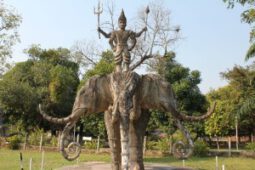
Buddha Park Highlights
It was built in 1958 by Luang Pu Bunleua Sulilat, a monk who studied both Buddhism and Hinduism. This explains why his park is full not only of Buddha images but also of Hindu gods as well as demons and animals from both beliefs.The most outstanding ones include Indra, the king of Hindu gods riding the three-headed elephant (aka Erawan and Airavata), a four-armed deity sitting on a horse and an artistic deity with 12 faces and many hands, each holding interesting objects. They are all equally impressive not only because of their enormous size but because they are full of interesting details and interesting motifs.
There is a local eatery and café offering food and drinks to tourists at one end of the park right next to the Mekong River that makes a great spot to chill after all the walking and climbing. Among the popular snacks are papaya salad, fried bananas and cold Lao beer. It also has a souvenir shop and restrooms. There is a small fee for entering the park as well as for photography.
Opening Hours: Daily from 08:00 – 18:00
Location: About 25 kilometres southeast of Vientiane, along the Mekong River
How to get there: The Buddha Park can be reached by public bus or tuk tuk
—————————–
Patuxai Victory Monument
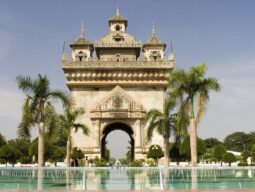
With its crenellated upper level topped with five ornate towers in the traditional Laos style, the Patuxai Victory Monument cuts a distinctive figure on the Vientiane skyline. It forms the centrepiece of Patuxai Park, and is dedicated to the Laos who were killed in the fight to gain independence from France, as well as from the nation’s earlier occupiers, Siam and Japan.
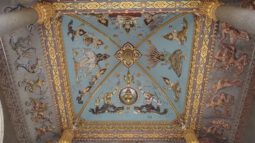
Situated at the end of one of the capital’s grand avenues, the large, square arch is reminiscent of the Arc de Triomphe in Paris. However, as a monument to Laos’ resilience and eventual independence, Patuxai was designed to pay homage to its national culture and traditions. Its exterior embellishments feature both Buddhist religious symbols such as lotus leaves and the stupa-shaped towers, and statues of animist kinnari (half-female and half-bird figures) and nagas (dragons).
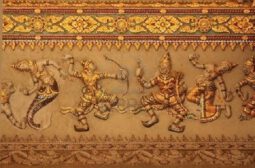
The interior of the monument is also richly decorated with painted walls and ceilings depicting gods, goddesses and elephants. For a small fee, you can climb to the top to enjoy the panoramic view of the charming, old-fashioned city of Vientiane with its many trees, low-rise buildings and temples, and all the way across the Mekong River to Thailand.
- Patuxai was built between 1957 and 1968 using funds from the U.S. government.
• It is sometimes nicknamed the ‘vertical runway’ as the cement used was intended for the construction of a new airport.
• The name comes from the Sanskrit words for door or gate (patu) and victory (jaya).
• Patuxai features four arches, facing North, South, East and West.
• The four corner towers and fifth central tower that crown the arch symbolise the five Buddhist principles of thoughtful amiability, flexibility, honesty, honour and prosperity.
• The seven floors of the monument contain administrative offices as well as a gift shop, a museum and the upper viewing galleries.
• Patuxai Park is a popular place to stroll around in the afternoons among the palm trees and lotus ponds. There is also a musical fountain that was donated by China.
• The peace gong at the northern end of the park was presented to Laos by Indonesia in recognition of Laos being named the world’s most peaceful country.
• For an entrance fee of 3,000 Kip (38 US cents) you can take the stairs or the new lifts to the top floor viewing area.
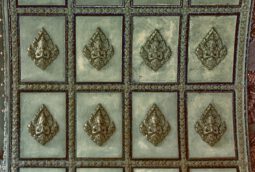
Opening Hours: From 08:00 to 16:30 on Mondays to Fridays, and 08:00 to 17:00 on Saturdays and Sundays.
Location: Patuxai is situated at the far end of Thanon Lane Xang in the government and diplomatic district. The monument sits on the large ‘island’ formed where the avenue splits into two, opposite the Ministry of Justice to the south and the Prime Minister’s office to the north.
How to get there: Vientiane is such a small city that it is easy to get around on foot, by bicycle, or by tuk-tuk. To get to Patuxai, head north-east from the Presidential Palace near the river and follow Thanon Lane Xang for five blocks until you see the imposing sight of the Patuxai arch.
———————————–
National Museum
A visit to the Lao National Museum, also known as the Lao National History Museum, is an excellent way to learn about the history, culture and people of Laos while spending a couple of hours out of the sun. Many of the exhibits are a bit faded and the old French colonial building is falling apart, but the museum covers a lot of ground, from prehistoric times to the modern day.

Although the range of artifacts and photographs is not as comprehensive or as well organised as you might expect in a national museum, there are nonetheless some fascinating exhibits here. The ground floor houses a mixture of ancient items such as dinosaur bones, pottery shards and Khmer sculptures that trace the early history of the region.
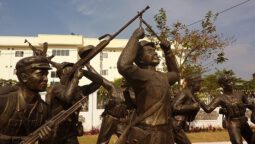
Upstairs, you will find more detail in the exhibits, which depict the turbulent modern history of Laos from the Siamese invasions and the French colonial period to the American military presence during the Vietnam War, and through to the present day. There is a heavy emphasis on the struggle for independence and the introduction of communism in 1975, which explains why the museum was originally named the Lao Revolutionary Museum.
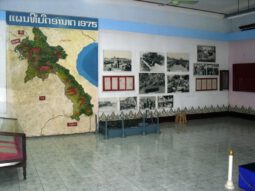
Lao National Museum Highlights
- The Lao National Museum is housed in the old French Governor’s mansion, which was built in 1925.
- Formerly known as the Lao Revolutionary Museum, it was renamed in 2000 and is sometimes also referred to as the Lao National History Museum.
- The exhibits of ancient Lao history and culture on the ground floor include a particularly interesting display from the Plain of Jars (Savannakhet), which features an intact jar from the site.
- Of the modern-day exhibits, many visitors find the one about unexploded ordinances from the American War the most fascinating and thought-provoking. From 1964 to 1973, Laos was heavily bombed, and many unexploded shells remain scattered around the countryside.
- Be prepared for many of the displays and their labels to show an anti-Western bias, describing the Americans in particular as ‘imperialists’.
- Stop and sign the guestbook at the entrance, and read some of the amusing exchanges on communism.
- The entrance fee is minimal.
- No bags or cameras are allowed in the museum. You will need to hand in your belongings for storage in the lockers at the entrance (free).
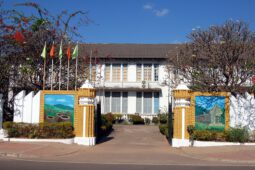
Opening Hours: From 08:00 to 12:00 and 13:00 to 16:00, seven days a week. Closed on public holidays.
Location: The Lao National Museum is located in the centre of town on Thanon Samsenthai, one block from the Lao Plaza Hoteland in front of the Tennis Club and the National Stadium.
How to get there: You can easily walk, ride a rented bicycle, or take a tuk-tuk or jumbo to the National Museum from anywhere in central Vientiane. Thanon Samsenthai is one of the main boulevards in the city, and runs parallel with the river.
———————————
Wat Si Muang
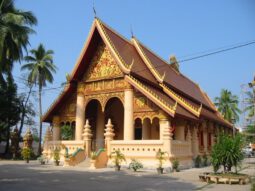
How to get there:
Wat Si Muang is one of Vientiane’s most popular sites of worship, and offers a fascinating insight into how old animist beliefs have blended seamlessly with Theravada Buddhism.
According to local legend, when the temple was being built in 1563 a young pregnant woman named Si Muang volunteered to sacrifice herself to appease the angry spirits. She threw herself into a hole in the ground where the building’s central pillar was to be placed, and was crushed when the massive pillar was lowered into position. This central pillar also formed the centre of the town that was springing up around Wat Si Muang, which to this day is revered as the ‘mother temple’ of Vientiane.
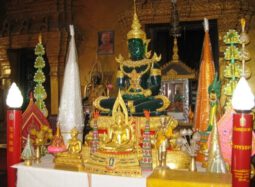
During the That Luang Festival every October or November, this temple is one of the focal points of the celebrations, and Si Muang is fêted as a guardian of the city. On a daily basis, Wat Si Muang attracts crowds of local Buddhists who want to benefit from its ‘good luck’ powers. It is commonly thought that if you pray for something here and simultaneously make a promise, your wish will be granted, providing you return and fulfil your promise.
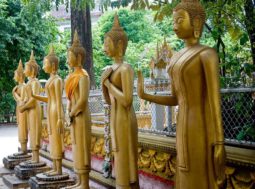
- The first Wat Si Muang was constructed in 1563, but was destroyed by Siamese invaders in 1828. It was subsequently rebuilt a number of times, and the present wat dates from 1915.
• The temple is named after Si Muang, who sacrificed herself in the pit that holds the central pillar of the structure. There is a small statue of Si Muang behind the building, along with a heap of old bricks that are said to date back to her time.
• The building itself is fairly unremarkable, although it does, unusually, contain two rooms rather than one. In the front chamber, you will find a monk offering blessings, while the back room contains an ornate altar where worshippers give their offerings.
• The interior of the temple is lavishly adorned in the usual manner with carved gold pillars, brightly coloured ceiling friezes and painted scenes from the life of the Buddha.
• There is no entrance charge, but you do have to pay to park your bicycle or motorcycle on the temple grounds.
• King Sisavang Vong’s monument is located next door, and is reachable through a gate from the Wat Si Muang grounds.
Opening Hours: The temple is open from 06:00 to 19:00 every day
Location: Wat Si Muang is located at the eastern end of Thanon Setthathirath, in the triangular area formed just before the street merges with Thanon Samsenthai and turns into Thanon Thadeua.
How to get there: Follow either Thanon Setthathirath or Thanon Samsenthai in an easterly direction towards the Friendship Bridge. If you are on Thanon Setthathirath, go past La Leela Hotel, and you will see the yellow Wat Si Muang on the other side of the street, surrounded by parked bicycles and motorbikes, as well as stalls selling flowers and other offerings.
————————————-
Wat Ho Phra Keo
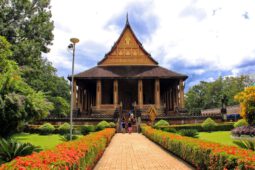
Vientiane boasts several beautiful temples or wats, but one of the most impressive and interesting of them is Wat Ho Phra Keo. It was originally constructed in 1565 as the Lao royal family’s personal chapel, and as a home for the Emerald Buddha after it was snatched from northern Siam (Thailand). This sacred jade statue was reclaimed by the Siamese in 1778 and now sits in Wat Phra Kaew in Bangkok.
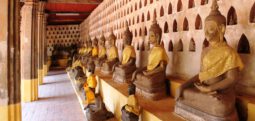
Even without the Emerald Buddha, however, Ho Phra Keo is well worth a visit. The only part of the old royal palace that has survived, the temple is no longer used for religious purposes and is now a museum. The Temple of the Emerald Buddha, as it is often known in English, is richly adorned with carved wooden features, a magnificent 16th century lacquered door with Hindu carvings, numerous Khmer stone carvings and a variety of Buddha statues.The stone balustrade of each of the temple stairs features a dragon with its head facing the grounds, guarding the sacred building. The shady, well-kept garden is an oasis of calm that offers a welcome respite from the sun and a quiet place to meditate or simply rest.
- The name Ho Phra Keomeans ‘Altar of the Emerald Buddha’, in reference to the fact that only the altar remained when the statue was removed
• It is also sometimes spelled Haw Phra Keow, Ho Prakeo or Ho Phra Kaew. English-language guidebooks often refer to it as the Temple of the Emerald Buddha.
• The temple was first built on the grounds of the royal palace in 1565, but was destroyed in the Siamese invasion of 1828-29.
• Prince Souvanna Phouma, an engineer and future prime minister of Laos, directed the reconstruction of Wat Ho Phra Keo between 1936 and 1942.
• Although it is relatively new, the Bangkok-rococo style structure has a distinctly traditional look.
• On its veranda you will see some of the finest examples of Buddhist sculpture in Laos.
• The interior of the temple is now a museum that houses many Lao treasures such as a gilded throne, Khmer Buddhist stone tablets, wooden carvings, bronze frog drums and palm-leaf manuscripts.
• The entrance fee is less than a dollar.
• The neatly tended garden contains colourful flowers, lush green lawns and charming statues set among the shady trees.
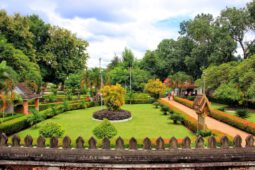
Opening Hours: The temple is open from 08:00 to 12:00 and 13:00 to 16:00 every day.
Location: Wat Ho Phra Keo is situated on the corner of Thanon Setthathilath and Thanon Mahosot. It is next to the Presidential Palace and across the road from Wat Si Saket. Mahosot Hospital is on the opposite side of Thanon Mahosot.
How to get there: As is the case with Vientiane’s other attractions, Ho Phra Keo is just a short stroll, bicycle ride or tuk-tuk trip from other parts of the city centre. From the main entertainment and business district, head east along Thanon Setthathilath or Thanon Fa Ngum, which runs along the river, and you will find the majestic Wat Ho Phra Keo in a tree-filled compound just after the Presidential Palace.
——————————-
Presidential Palace
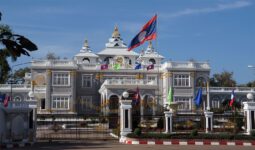
The building of the elegant Presidential Palace on Lane Xang Street was first started in 1973 by the then Royal Lao government on the grounds that used to house the royal residence. It was designed by local architect Khamphoung Phonekeo, but due to political change brought about by the takeover of the communist Pathet Lao in 1975, the building was not completed until much later.
The Presidential Palace finally opened its doors in 1986 and even then only as a venue for government functions and ceremonies. The building is closed to the public.
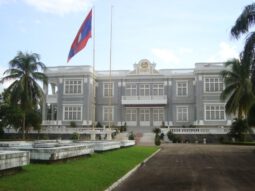
The Presidential Palace is a well-known landmark for its imposing yet elegant beau arts-style architecture complete with tall colonnades and shaded balconies. The building is surrounded by well-manicured lawns and gardens and fenced off by tall walls and a wrought iron gate.
The Presidential Palace is not to be confused with the official home of the Lao president, which is located in the Vientiane suburb of Ban Phonthan. This magnificent building is lit up in the evening and offers a great opportunity for night photography although a long lens may be needed.
Location: Junction of Lane Xang Avenue and Settathirath Road, Vientiane
—————————
That Luang – Vientian Great Stupa
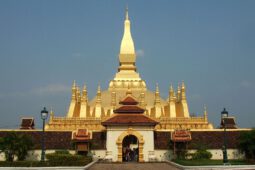
That Luang, or the Great Stupa, in Vientiane is a national symbol (its image is on Laos’ official seal) and also the most sacred monument in the country. From the outside That Luang looks more like a fortress surrounded by high walls and it features two temples with the main stupa, the top of which is covered with gold leaf, standing 148 feet tall.
The beautiful architecture is in Lao style, influenced by Buddhist beliefs – these include finely-gilded, red-lacquer doors, pointed lesser stupas, many Buddha images and beautiful flower and animal images.
Locals say that it was originally built as early as the third century to house a breastbone of the Lord Buddha brought to Laos by an Indian missionary. However, the current structure was built by King Setthathirat in 1566 on the site of a 13th century Khmer ruin. He named Vientiane the capital after Luang Prabang in the mid-sixteenth century. An elegantly crafted statue of him stands in front of the main entrance to That Luang.
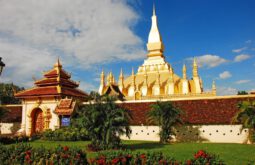
That Luang was greatly damaged by the Burmese, Chinese and Siamese during invasions in the 18th and 19th centuries then was basically left alone until French colonial times. Restoration work was completed in 1900 by the French and for a second time in 1930, again with the help of the French.
Every November when the Boun That Luang Festival is held in Vientiane, a large crowd of followers and tourists come to town from all over Laos and neighbouring countries. The festival is considered the most important Buddhist celebration in Laos with many activities going on for three days and three nights. The main event is always held at That Luang and thousands of people come to pay respect to the stupa and to enjoy the colourful event that includes parades, live music and religious ceremonies.
Opening Hours: All year round
Location: The impressively gilded structure is situated about four kilometres northeast of Vientiane
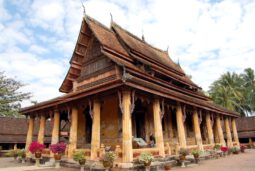
Wat Si Saket located in Vientiane is famous for its cloister wall housing thousands of tiny Buddha images and rows with hundreds of seated Buddhas. These images mainly date from the 16th and 19th centuries and come in all sizes and are made from wood, stone and bronze – more than 6,800 Buddhas in total.
If visiting the temple early in the morning, visitors will come across the many locals that go to pray and make merit as well as to offer food to the monks. It is a charming daily ceremony to witness. The temple is quite shady as it is surrounded by tropical fruit trees.

Wat Si Saket is not only famous for the interior walls of the cloister but it also has beautiful architecture and layout with history dated back to 1818. Among the many interesting features there are its lovely surrounding verandas, an ornate five-tiered roof, a drum tower, a small library building with a Burmese-style roof and the flowered ceiling of the ordination hall.
Located opposite the Presidential Palace, the temple was built by Chao Anuvong, the last king of the Lan Xang Kingdom in early Bangkok-style architecture mixed with its own unique style. It survived the Siamese-Lao war of 1828 and has become the oldest Buddhist monastery in Laos.
Art enthusiasts will be thrilled to see many figurines and sculptures fashioned by highly skilled craftsmen such as the five-metre long beautiful detailed wooden naga (in Sanskrit, it means serpent deity) as well as a Khmer-style Buddha seated on a coiled naga.
Opening Hours: Daily from 08:00 – 16:00
Location: On Lan Xang Road (across the street from the Presidential Palace), Vientiane
===========================================
Luang Prabang – UNESCO Heritage
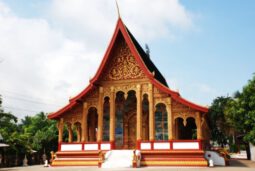
The ancient town of Luang Prabang situated in northern Laos, was designated a UNESCO World Heritage Site in 1995. Considered by many travellers and writers as being the heart of Laotian culture, the tiny town is encircled by mountains and is 700 metres above sea level at the confluence of the Nam Khan and Mekong Rivers. Here visitors are subjected to an inflamed economic bubble that does not apply to the rest of the country. Being Laos’ premier tourist destination and (arguably) Southeast Asia’s most beautiful spot, ironically tourists will pay more for the innate pleasures of eating, drinking and sleeping than they would in the country’s capital city Vientiane.
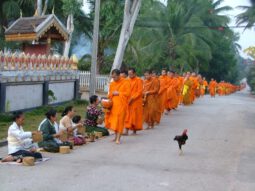
Luang Prabang was the ancient royal capital of the Lan Xang Kingdom until King Phothisarat moved the administrative seat to Vientiane in 1545. Regardless, it has continued to overlook Vientiane as the destination of choice with its amalgamation of crumbling French architecture, glistening temples and extensive natural beauty. Even the hardest of hearts would have a struggle not to warm to the place. The town’s entire historical section is dedicated to tourism, with everything from former royal palaces to over 33 Wats (temples), on the tourist trail. This former Royal capital still remains the main centre for Buddhist learning in Laos and is the perfect location for spiritual contemplation.

Cascading waterfalls, scaling peaks and the milky-brown waters of the Mekong River provide ample opportunity to swim, climb and sail your way through Luang Prabang. It is only as recent as 1989 that Laos opened up to tourism and the country that had previously been cut off from the rest of Southeast Asia developed a small but steady economy, based on tourism and regional trade. This small and gentle town where most locals are asleep by 22:00 is now one of the richest and most visited provinces in Laos. It’s one of the few places where you feel that this is the genuine article and one that retains its unique ambiance.
——————————
Best things to do in Luang Prabang
Luang Prabang literally meaning “Royal Buddha Image”, was listed in 1995 for unique and “remarkably” well preserved architectural, religious and cultural heritage, a blend of the rural and urban developments over several centuries, including the French colonial influences during the 19th and 20th centuries
The center of the city consists of four main roads and is located on a peninsula at the confluence of the Nam Khan and Mekong River. Luang Prabang is well known for its numerous Buddhist temples (33 to be exact) and monasteries.
The city is not only famous for its calm beauty and never fading culture , but also for its beautiful evergreen nature. Not far away from town, we can find plenty nature parks, which help bring you back into the nature, escaping from the busy daily life.
Easy walk to explore the ancient city of Luang Prabang
There are dozens of temple complexes around town and visitors are welcome to wander around as long as they are respectful and cover up inside the buildings themselves.
We recommend you to start from Wat Xiengthong, which is one of the most important of Lao monasteries and remains a significant monument to the spirit of religion, royalty and traditional art.
There are over 20 structures on the grounds including a sim, shrines, pavilions and residences, in addition to its gardens of flowers, ornamental shrubs, and trees.
From there, we can make a short visit to the old temple of Wat Sene Souk Haram, literally “Temple of a 100 000 treasures”, which is the first monastery in town whose vihan was covered with yellow and red tiles in the modern Thai fashion.
Wat Xiengthong, Luang Prabang
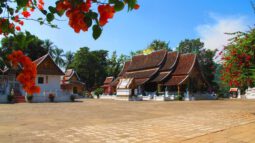
Continue further down the street, you cannot ignore Luang Prabang National Museum, the form Royal Palace, whose architecture has a mixed of traditional Lao motifs and French Beaux Arts styles.
The nearby Wat Mai, built in the 18th century, is the largest and most richly decorated of the temples in Luang Prabang.
In the afternoon, continue the visit with some more unique temple of Wat Visoun and Wat Aham before taking the visit to the Traditional Arts and Ethnology Center (TAEC).
Established in 2007, TAEC has inspired visitors by exploring, celebrating, and preserving the diverse ethnic cultures and peoples of Laos through professionally curated permanent and special exhibitions, events, and craft workshops.
You can learn more about Lao culture and tradition with its plenty ethnic minorities in the TAEC section below in this article.You can either ascend mount Phousi to watch the sunset with the panoramic view over the city, or spend a peaceful moment at the riverside temple of Wat Prabaht. Both gives you the unforgettable finish of the day
Cruise the Mekong River
Mekong river is the blood of Laos, which does not only supply the water for daily life, but also the easiest route to connect the different mountainous parts of the country.
Luang Prabang itself has plenty of benefits from the river, especially for tourism. Cruising the mighty Mekong is one of the most exciting experience when travelling to Luang Prabang.
During day time, you can either take the upstream cruise to the mysterious Pak Ou cave in the north of the city; or enjoy the leisure downstream cruise to Kuang Si waterfall in the south.
Along the way, there are plenty of stop to visit the local authentic traditional villages to learn about traditional weaving, saa paper making, or wine distilling.
Before the dust falls over the city, it is also the best time to enjoy a sunset cruise and have dinner on board while watching the traditional dance & folk song. Further detail in the Sunset and Dinner Cruise below.
Nahm Dong Park – Back to nature
Located only 10 Km from the center of Luang Prabang , Nahm Dong Park is 18 hectares of beautiful plants, lush greenery, exquisite flora and fauna and rushing waters.
The area is spotted with cosy picnic places, some under straw huts, some in flower gardens. You could spend an entire day lounging, swimming, trekking and enjoying this natural preserve.
Not only are you immersed with this beautiful greenery that is easy to navigate, but you are also in a self-sustaining destination.
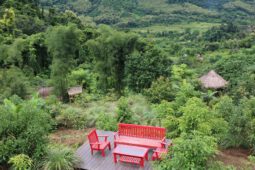
Pha Tad Ke Botanical Garden
Pha Tad Ke is the first and only botanical garden in Luang Prabang, offering a collection of tours, workshops and activities for visitors!
The garden locates on the other side of Mekong with a 15-minute boat ride downstream the river. You can spend half day stroll around the garden to learn more about the trees in Laos, take a short hike to the nearby Buddha cave, read a book by the Mekong, or sip a tea by the lotus pond.
Enjoy a beautiful lunch there before joining the boat back to Luang Prabang; or you can either spend the afternoon to join the workshop about the permaculture, herbal tea, or taking the cruise further down to Kuang Si waterfall to refresh with the cool clear water.
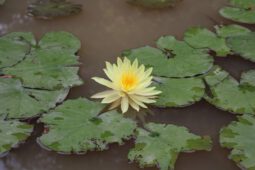
Pha Tad Ke Garden
Refresh at Kuang Si waterfall
Kuang Si Waterfalls, is a three leveled waterfall about 29 kilometres (18 mi) south of Luang Prabang.
These waterfalls are a favorite side trip for tourists in Luang Prabang. The falls begin in shallow pools atop a steep hillside. These lead to the main fall with a 60 metres (200 ft) drop.
You can spend the whole day exploring the falls, hiking up to the top to enjoy the panoramic view. You can also combine with the visit to some interesting stops along the way including Buffalo Dairy Farm, and Butterflies Park (see below).
Need some adventure? The morning trek from Ban Long Lao through the jungle, ending at the top of the falls is the good choice.
After all, the cool clear natural pool is always calling for your visit. Do not hesitate to take a dip, or you will regret it.
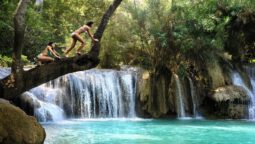
Kuang Si waterfalls
Butterflies Park
Situated 300m before the entry of the Kuang Si Waterfall, Butterfly Park is a project that was initiated in January 2014 from 2 passionate Dutch people.
The mission is to create a research center studying and publishing about Laos butterflies, host plants and preservation because of environmental issues in Laos.
The Butterfly Park is open for schools to raise awareness about the beautiful and vulnerable nature in Laos, will provide them with learning materials to educate and understand the importance to preserve their beautiful nature for their health, happiness and financial security in the future.
The Butterfly Park wants to create funding as well for local schools. So those children can come to learn about their local nature.
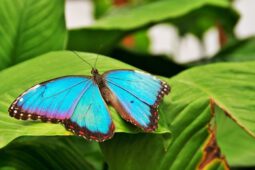
Butterflies Park
Laos Buffalo Dairy
Have you ever heard of milking the buffalo?|
No? Come to watch it at Buffalo Dairy Farm.
Yes? The farm itself has an excellent story to tell you.
Laos, as an agriculture country, full of buffalo, it is quite strange that milking buffalo is something unimaginable some years ago.
This is where the story started.
Buffalo Dairy Farm is a socially-responsible enterprise consisting of a commercial dairy and production facility to make products such as yogurt, cheese and ice cream for local and overseas customers.
Come and see how they help Lao farmers with having some extra income from milking their buffalo.
Locating on the way to Kuang Si waterfall, you can combine the visit in the morning, then refresh at Kuang Si waterfall.
Elephant Experience
NO DOUBT! This is one of the most exciting experience you have in Luang Prabang.
There are 6 elephant camps in Luang Prabang for you to choose from depending on your plan and preference.
The first one we recommend is MandaLao Elephant Conservation Center, which focusing on the non-riding elephant tour.
The center offers the half day excursion (morning or afternoon), or full day interaction with the elephant. All starts with a short lecture about the elephant and its living condition in Laos.
The second one is the Elephant Village, which is the first of its kind in Luang Prabang. Here you can enjoy the elephant ride of about 30 minutes and combine with the visit to the exciting Tad Sae waterfalls.
There are the option of (1) full day excursion including some trekking in the nearby area; (2) the option of learning some Mahout skills; or (3) you can also spend 2 to 3 days with the elephant if you wish.
For the one looking for some different experience, learning about making paper from elephant dungs is for you.
There are 2 nearby camps in the area including All Laos Elephant Camp, which offers quite the same excursion with Elephant Village but less professional services; and the small camp with 4-5 elephants near Tad Sae waterfall, where you can enjoy the 30-minute-to-1-hour elephant ride.For the one with limited time but still wish to enjoy a short elephant ride, we recommend the one in Ban Xanghai to combine with the day to Pak Ou cave. And on the day to Kuang Si waterfall, you can make a short stop at Luang Prabang Elephant Camp to have some interaction.
Rice Experience at Living Land Farm
The best farming experience in Laos, the Living Land Lao company offers you the best the land has to offer and a rare glimpse into the lives of traditional rice farmers in Luang Prabang.
In this course, you will be able to experience how it is like to plough the land, plant rice, harvest them, thresh and eventually cook up a traditional meal!
Set in a beautiful farmland about 20 minutes from town, it is peaceful and serene yet bustling with life as all sorts of plants and animals interact in a thriving ecosystem.
Besides farming, you will also get to see a host of other traditional crafts such as blacksmiths, bird traps, musical instruments and a whole lot more.
Also comprising a zen-like lotus lake, and an organic garden with more than 30 types of vegetables and fruits, it will delight the plant-lover in you, if not inspire the creation of one!
Tad Sae waterfall
Tad Sae waterfall is a spectacular natural wonder best appreciated in the wet season.
Despite not being as high as Kuang Si waterfall there are many more streams of water which cascade and make a thunderous sound following plenty of rain.
The falls pour over beautiful limestone formations across a variety of levels into large pools below, which are fantastic to swim in.
Tad Sae is only reached by boat, making it quite an adventure and an opportunity to retreat into nature and get close to the locals who head there in groups over the weekend.
Normally, you can combine Tad Sae waterfall with a 2-hour trek exploring the area with some authentic village.
More adventurous tourists can also enjoy some biking in the morning, spend time at the waterfall, enjoy the picnic, then take part in the kayaking downstream the Nam Khan river back to the town of Luang Prabang
There is a small elephant camp nearby if you want to experience something different.
Explore the other sides of Mekong river
For the one looking for a deeper cut of authenticity, catch a water taxi to the other side of Mekong river, you find yourself half a planet away.
Its simplicity and low-key temples belie the fact that we were only minutes from well-traveled Luang Prabang.
To start, we recommend you to take the cruise to Pha Tad Ke garden and spend half day to explore the bio-system of Laos. See more detail in Pha Tad Ke part above.
On the way back in the afternoon, you can make the stop to visit traditional Ban Chan village, which is famous for its traditional pottery-making, where you can watch pots being hand-thrown and fired in old ovens.
The village’s lamps and pots decorate the small streets of Luang Prabang’s old town, and are known all over northern Laos.
The final stop of the day is at Ban Xiengmene, stroll around the village to watch the life of local people, visit Tham Sakarin cave, and end up with ascending to the summit of the hill, home to Wat Longkhoune, where we can enjoy the panoramic view over the area to see yourself the contrast of the 2 sides of Mekong river.
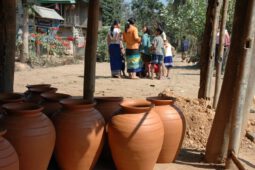
Green Jungle Park – Tad Hoikhua waterfall
Some 15 kilometers from the other side of the Mekong river, you will find Green Jungle Park which is a great slice of greenery in the middle of the countryside.
One of the main activities here is zip lining and there are some 900 meters of zip lines to try out in the park.
As if that wasn’t enough you can also enjoy monkey bridges as well as rope lines which will let you check out the jungle canopy from above.
You will also find a nice cafe here and some gardens that make a good place to go for a stroll in the afternoon.
The park is also studded with limpid pools which make the perfect place to cool off in the afternoon.
The waterfall of Tad Hoikhua is also the reason for the tourist to come here during the raining season.
You can combine the visit to Green Jungle Park with the visit to the local village of Ban Xiengmene on the way back to admire the panoramic view from Wat Longkhoune
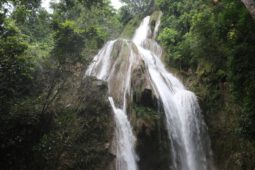
Visit Morning Market to admire daily life
Luang Prabang morning market is where the daily life of Luang Prabang starts.
This small market is the Laotian “supermarket” where they come to buy their fresh fruit, vegetables and meat, which are proposed in showcases which are not always the way we use to see in most of our countries.
Some products are coming from the jungle around and will be for sure highly exotic for travelers from western countries.
Very active as from 8 o’clock in the morning, it is a typical passing spot for Laotians who come to buy and/or to sell.
There’s a lot going on! You can find many unusual foodstuffs like ox-blood which is proposed in gelatinous cubes, serpents, bats, grilled insects (worms, grasshoppers, bee’s larvae, crickets, butterfly chrysalis), giblets covered with flies, caramelised pork’s head, and all sorts of leaves and plants which are used to make the traditional dishes.
You can find Thai products, cultivated in greenhouses, as well as the seasonal Lao products.
Freshly caught fish, bunches of local flowers especially made for leaving in the temples as offerings, as well as many other items … A must see!
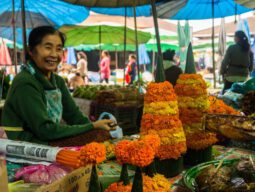
Morning market
Stroll around the Night Market
No visit to Luang Prabang is complete without visiting the amazing Luang Prabang Night Markets. It is a place where locals and tourists come together to converse, shop and eat all in one location.
The Evening Market is a nightly event that takes place between 17:00 and 23:00 beginning at Wat Mai and running along Sisavangvong Road to the town centre (Settathilat Road).
The street is closed off to vehicles and the hill-tribe traders emerge with their various apparels, ceramics, bamboo, lamps, blankets, bed covers, handicrafts and silk scarves.
Vendors often quote higher prices than when buying from the shops during day time, so make sure you haggle (politely) or shop around first.
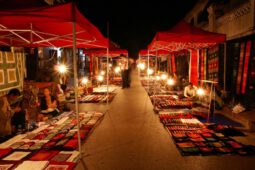
Bolaven Plateau Waterfall
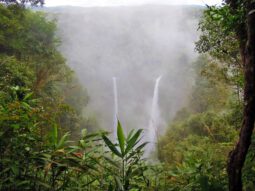
Bolaven Plateau in southern Laos is famous for its great scenery, ethnic villages and unexplored corners. It’s probably best known for being home to some of Southeast Asia’s most spectacular waterfalls including Tad Fane and Dong Hua Sao (aka Taat Fang). The plateau’s elevation ranges approximately from 1,000 to 1,350 metres above sea level and here the weather in general is milder than the rest of the country, getting cool, especially at night.Its fertile plains allow farmers to produce some of the best tea and coffee in the country (coffee remains Laos’ biggest agricultural export.) Tourism has become another important source of income for locals as the area has almost unlimited trekking and daytrip opportunities.
Bolaven Plateau & Tad Fane Waterfall
The impressive Tad Fane twin falls thunder over 100 metres down the steep cliffs into a gorge, located a few kilometres west of Paksong Town, Champasak Province. The scenic rainforest spot is part of a big national park where wild animals live, including leopards, tigers, elephants and monkeys. Hornbills are among the 300 bird species found in this area.
Opening Hours: All year round. The waterfalls are more impressive in the rainy season between July and October. If visiting between the months of October and February, visitors can observe the harvesting of coffee around the plateau
Location: Bolaven Plateau is situated in the northeast of Champasak Province, covering parts of Salavan, Attapeu and Sekong provinces. The main town to use as a base is Pakse in Champasak
How to get there: Pakse has a large bus station with regular connections to other parts of Laos. It also has a small airport
——————————-
Tad Lo
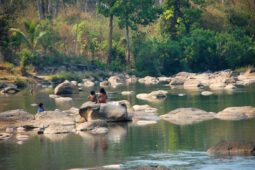
Located in Salavan Province, Tad Lo is a trekking stopover for travelers and is especially popular with those on a budget. This village in Laos is two kilometres away from the point at which the bus drops you off. From here you can take a tuk-tuk for a nominal amount.
There are three waterfalls in this village: Tad Suong, Tad Lo and Tad Hang. Most of the local community is built up around this area.
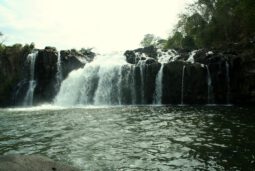
If you want to take a quick swim Tad Hang is the best bet for you. The water is not too rough as long as you stay away from the falls themselves. Fishing is very common and though the water is not crystal clear, it is not unhealthy.
If you cross Saise Resort over the bridge you should reach Tad Lo waterfalls. Although you may not be able to take a dip in the rocky waters of this fall, spend some time sitting on the bank and enjoy its view.
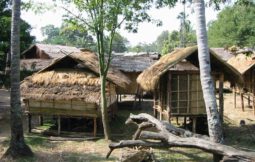
Tad Suong is furthest from the village and the most beautiful out of the three. It is a brilliant experience to watch the water splash down through the sharp gorges of the fall.
Tad Lo has three waterfalls, one of which is beside the village, the second a kilometre away upstream, and the third is further upstream about eight kilometres away. If you walk along the left bank of the river you should be able to find your way through the jungle path to the second waterfall. The sound of the waterfall will guide you down to the base of the waterfall along the manmade flight of stone steps. Here you can take a swim as well.
——————————-
The Plain of Jars
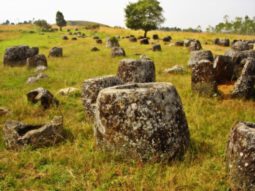
The Plain of Jars is considered the most distinctive and enigmatic of all Laos attractions. The large area around Phonsavan, the main city of Xieng Khouang Province is dotted with stone jars but no one has a clear idea as to why they are there.
The mysterious jars were carved from both sandstone and granite in various sizes from very small to about 3.5 metres high and are thought to be more than 2,000 years old. Legend has it that they were made to store rice wine while some believe they were for storing the dead. Until today the function of the jars is still disputed.
The Plain Of Jars Highlights
Of all the many jar sites, the three most popular ones to visit are known as Site 1, 2 and 3. The main reason is because they are safe from UXO (unexploded ordinance). Still, visitors are advised to walk only on the known routes as Laos is considered the most heavily bombed/mined country in the world. During the Vietnam War this area got hit hard and some of the bombs did not go off. Site 1 is where the biggest jar is located. While Site 2 and 3 offer picturesque views of farmlands and villages as they sit on top of small hills.
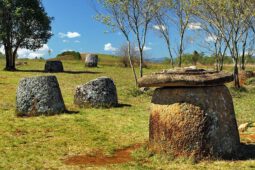
Opening Hours: All year round
Location: Around Phonsavan, the main town of Xieng Khouang Province in Northeast Laos. Site 1 is about 15km southwest of Phonsavan and has about 300 jars. Site 2 is about 25km south of Phonsavan and contains about 90 jars spread over two hills. Site 3 is about 35km southeast of Phonsavan and contains about 150 jars. It’s actually only 10km away from Site 2.
How to get there: It’s easy to hire taxi (4WD and driver) from Phonsavan to the jar sites or visitors can catch a local bus to Site 3 but not site 1 and 2
———————————————
Wat Phu
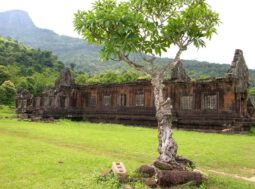
Wat Phu (meaning ‘mountain temple’), is situated on a hillside and offers stunning views over the surrounding land and Mekong River. Visitors who appreciate art and history will be amazed by the magnificent workmanship in this ruined Khmer temple complex in the form of temple pillars, barays, lintels, pediments, terrace, courtyard, walls, doorways, sanctuary, shrine, library and palaces.
There is also a natural spring that is believed by locals to emit holy water. Older than the great temple complex at Angkor Wat in Cambodia, Wat Phu was named a World Heritage Site by UNESCO in 2002.
Wat Phu (Vat Phou)
Wat Phu is considered one of the oldest archaeological sites in Laos. One temple in the site was constructed around the 5th century but most buildings found in the complex are from the 11th to 13th centuries. Like other notable Khmer architecture in Southeast Asia, it was constructed using sandstone, laterite and bricks. Among many of the outstanding carvings there are the Indra, the Hindu god of war, storms, and rainfall, riding a three-headed elephant and Vishnu riding on a garuda, an eagle.
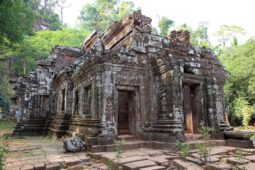
Wat Phu has been an active temple for Buddhist religious practice for quite some time because Buddhism replaced Hinduism in Laos in the mid 13th century. There is an altar at the front section of its sanctuary featuring four big Buddha images with more Buddha images around the ruins.
If you visit Wat Phu on the full moon of the third lunar month (usually in February), you will come across the temple’s biggest annual festival with many impressive ceremonies and fun activities going on during the week-long period. These include monk-blessing ceremonies, elephant racing, buffalo and cock fighting as well as a trade fair. The event is never short of entertainment such as live music and traditional Lao dancing.
Opening Hours: All year round
Location: In Pakse, the main city of Champasack Province in southwestern Laos
How to get there: Visitors can travel to Wat Phu from Pakse via land or by boat along the Mekong River
————————————
Bokeo
Situated in the heart of the golden triangle, Bokeo is just over the border from Chiang Rai province in Thailand and also borders Myanmar while China is less than 100km away. Although Bokeois the smallest province in Laos, it harbours a large number of interesting minority groups (approximate 30 ethnicities). The province split off from Luang Nam Tha and was created in 1983. The name Bokeo translates as ‘gem mine’ and the city is known as the ‘land of sapphires’. Panning for gold, and digging for precious stones is a major occupation here.
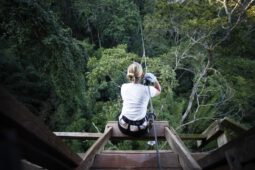
Huay Xai, the capital provincial of Bokeo, sits on the bank of the Mekong River. Like most minor cities in Laos, several temples built in earlier centuries and surrounding villages seem to be the only attractions. However, Bokeo’s real economic strength is tourism. A holiday among a network of hunts and shelters built on top of trees in primary monsoon dry deciduous forest is a decidedly appealing one. A perfect spot where one can observe the forest’s rare habitants from above. Besides fascinating attractions and delightful activities, Houay Xai is also known as the gateway to explore the rest of Laos, a famous stopover spot for most arrivals before boarding a boat and heading southeast to Pak Beng and Luang Prabang. A trip up north on Bokeo’s winding and bumpy roads will lead to Luang Namtha and beyond.
Over the centuries, Bokeo has remained an important stopover for Chinese traders traveling by boats between China and Thailand. Nowadays, the only connection between Bokeo and Chiang Rai is via ferry and speedboat. However, a bridge between Laos and Thailand is scheduled to open in 2012.


